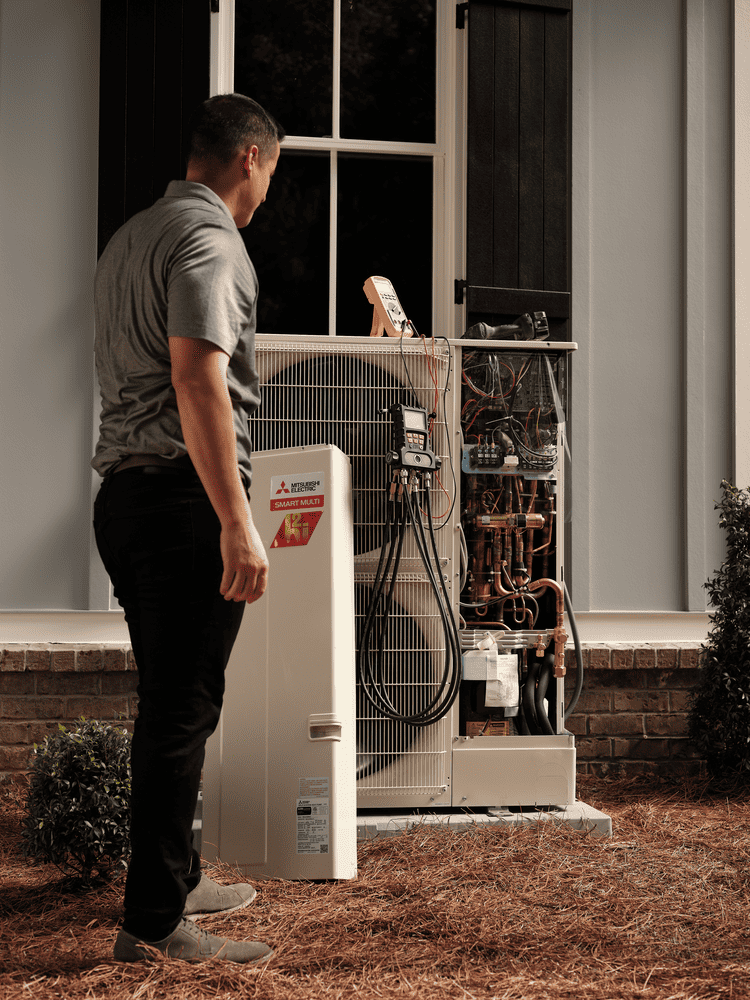Check the power supply and ensure the remote control batteries are functional. Clean or replace filters regularly.
Mitsubishi mini splits are known for their efficiency and reliability. Even the best systems can face issues over time. Common problems include power supply issues, dirty filters, and malfunctioning remote controls. Regular maintenance helps keep the system running smoothly. Cleaning filters monthly and checking the power supply can prevent many issues.
If problems persist, consulting the user manual or contacting a professional technician is advisable. Proper troubleshooting can extend the lifespan of the unit and maintain its efficiency. By addressing minor issues promptly, you can ensure a comfortable indoor climate year-round.
Introduction To Mitsubishi Mini Splits
Contents
The Mitsubishi Mini Split systems are popular for home and office cooling. They offer efficient, zone-specific temperature control. These units are also known for their quiet operation and energy-saving features. Understanding Mitsubishi Mini Splits helps in troubleshooting minor issues yourself.
Popularity Of Mini Splits
Mini Split systems are gaining popularity rapidly. They are versatile and easy to install. Here are some key reasons for their popularity:
- Energy Efficiency: Mini Splits consume less energy.
- Zone Control: They allow individual room temperature settings.
- Quiet Operation: They produce minimal noise.
- Compact Design: Mini Splits have a small footprint.
Mitsubishi’s Market Presence
Mitsubishi is a leader in the Mini Split market. They offer advanced technology and reliable products. Here are some features that set Mitsubishi apart:
- Innovative Technology: Mitsubishi units come with advanced features.
- Durability: Their products are known for long-lasting performance.
- Customer Support: Mitsubishi provides excellent customer service.
- Eco-Friendly: Their systems are designed to reduce environmental impact.
For those new to these systems, understanding their basics is crucial. Mitsubishi Mini Splits offer many advantages, making them a preferred choice for many.
Common Issues With Mini Split Systems
Mitsubishi mini split systems are reliable and efficient. But sometimes, they face common issues. Knowing these problems helps keep your system running smoothly.
Temperature Inconsistencies
Mini split systems sometimes struggle with temperature inconsistencies. This can be frustrating. Here are some possible causes:
- Dirty Filters: Blocked filters can restrict airflow. Clean or replace them regularly.
- Thermostat Issues: Check if the thermostat is set correctly. It should be in the right mode.
- Refrigerant Leaks: Low refrigerant levels cause uneven cooling or heating. Call a professional to check for leaks.
Unusual Noises
Unusual noises from a mini split system can signal trouble. Different sounds indicate different issues:
| Noise | Possible Cause |
|---|---|
| Banging | Loose or broken parts inside the unit. |
| Clicking | Electrical issues or a failing thermostat. |
| Hissing | Refrigerant leaks or high pressure in the unit. |
If you hear any of these noises, it’s best to act quickly. Ignoring them can lead to bigger problems.
The Importance Of Regular Maintenance
The Mitsubishi Mini Split system is a reliable and efficient HVAC solution. However, like any other HVAC system, it requires regular maintenance. Proper care ensures optimal performance and prevents unexpected problems. Regular maintenance keeps your unit running smoothly and efficiently.
Preventing Problems
Regular maintenance helps in preventing problems before they start. It identifies potential issues early on. This proactive approach saves time and money. A clean filter ensures proper airflow. Dirty filters cause the unit to work harder. This leads to higher energy bills and potential breakdowns.
- Check and clean the filters monthly.
- Inspect the outdoor unit for debris.
- Ensure proper refrigerant levels.
- Examine electrical connections.
Extending Unit Lifespan
Regular maintenance extends the lifespan of your unit. A well-maintained unit lasts longer and performs better. Neglecting maintenance shortens the unit’s lifespan. Regularly checking and cleaning the unit is crucial.
| Maintenance Task | Frequency |
|---|---|
| Filter Cleaning | Monthly |
| Refrigerant Level Check | Annually |
| Electrical Inspection | Annually |
| Debris Removal | Monthly |
Regular maintenance keeps your Mitsubishi Mini Split in top condition. It ensures a comfortable home environment. Follow the maintenance tips to enjoy a trouble-free HVAC system.

Credit: www.richaircomfort.com
Troubleshooting Guide
This guide will help you troubleshoot your Mitsubishi mini split system. Follow these steps to resolve common issues. It includes easy checks and error code meanings.
Start With The Basics
Begin with simple checks before diving into complex solutions. First, ensure the unit is plugged in and turned on. Check the remote control for dead batteries. Verify the circuit breaker is not tripped. Clean the air filters regularly to avoid blockages.
Next, inspect the outdoor unit. Make sure there is no debris obstructing the airflow. Ensure the unit has enough space around it to breathe. These simple steps can often resolve many minor issues.
Error Codes And Meanings
Mitsubishi mini splits display error codes for quick diagnosis. Here are some common error codes and their meanings:
| Error Code | Meaning |
|---|---|
| U1 | Low Voltage |
| P1 | High Voltage |
| E1 | Communication Error |
| F1 | Indoor Unit Sensor Fault |
| F2 | Outdoor Unit Sensor Fault |
If your unit shows an error code, refer to this table. Match the code to understand the problem. Some issues may need a professional for repair.
Diy Quick Fixes
Dealing with issues in your Mitsubishi Mini Split can be frustrating. Before calling a technician, try these DIY quick fixes. These easy steps can solve common problems and save you time and money.
Filter Cleaning
A dirty filter can reduce efficiency and cause issues. Cleaning the filter is a simple and effective fix.
- Turn off the unit and unplug it.
- Open the front panel and remove the filter.
- Use a vacuum to remove dust and debris.
- If very dirty, wash it with lukewarm water and mild soap.
- Let it dry completely before reinstalling.
Remote Control Resets
Sometimes, the remote control stops working properly. Resetting it can often solve the problem.
- Remove the batteries from the remote control.
- Wait for 30 seconds.
- Reinsert the batteries.
- Press the reset button (if available) with a small pin.
- Test the remote control to see if it works.
These quick fixes can help get your Mitsubishi Mini Split back in shape. Always check the user manual for specific instructions related to your model.
When To Call A Professional
Maintaining your Mitsubishi mini split can be straightforward. But some issues require expert help. Knowing when to call a professional can save you time and money.
Complex Technical Issues
Some problems with your Mitsubishi mini split are hard to fix. These include:
- Refrigerant Leaks: Fixing leaks needs special tools.
- Electrical Problems: Wiring issues can be dangerous.
- Sensor Failures: These need expert diagnostics.
Trying to fix these yourself can cause more damage. Always call a professional for complex issues.
Warranty Considerations
Your Mitsubishi mini split may have a warranty. Fixing it yourself can void this warranty. Here are some points to consider:
| Action | Warranty Effect |
|---|---|
| DIY Repairs | May void warranty |
| Professional Service | Keeps warranty valid |
Always check your warranty terms before fixing anything. It’s best to call a professional to keep your warranty safe.
Upgrading Your Mini Split System
Upgrading your Mitsubishi mini split system can enhance comfort and efficiency. Whether it’s an old unit or recent advancements, knowing when and how to upgrade is essential. This section covers signs for an upgrade and choosing a new model.
Signs It’s Time To Upgrade
Is your mini split system showing signs of wear and tear? Here are common signs that indicate an upgrade might be necessary:
- Frequent Repairs: If your system needs constant repairs, it may be time to upgrade.
- High Energy Bills: Older units can consume more energy, leading to higher bills.
- Inconsistent Temperature: Struggling to maintain a consistent temperature is a red flag.
- Loud Noises: Unusual noises can mean the system is wearing out.
- Poor Air Quality: An inefficient unit can affect indoor air quality.
Choosing A New Model
Selecting the right Mitsubishi mini split model is crucial for optimal performance. Consider these factors when choosing your new unit:
- Energy Efficiency: Look for high SEER ratings for better efficiency.
- Capacity: Ensure the unit’s capacity matches your room size.
- Features: Modern units offer advanced features like Wi-Fi control and smart sensors.
- Noise Level: Opt for models with low noise levels for a quieter environment.
- Warranty: Check the warranty period for better peace of mind.
Here is a quick comparison table to help you decide:
| Model | SEER Rating | Capacity (BTU) | Features |
|---|---|---|---|
| Mitsubishi MSZ-FH | 26 | 9,000 | Wi-Fi, Smart Sensors |
| Mitsubishi MSZ-GL | 22 | 12,000 | Quiet Operation |
| Mitsubishi MSZ-EF | 20 | 15,000 | Sleek Design |
Choose a model that fits your needs and budget to enjoy better comfort and savings.

Credit: www.richaircomfort.com
Preventative Measures For Future
Preventative measures can save you time and money on Mitsubishi Mini Split repairs. Regular maintenance ensures your unit works efficiently and lasts longer. Below are tips to keep your Mini Split in top condition.
Seasonal Tips
Each season brings different challenges for your Mitsubishi Mini Split. Follow these tips to ensure optimal performance year-round.
- Spring: Clean the filters and check for any blockages.
- Summer: Inspect the outdoor unit for debris and ensure good airflow.
- Fall: Clean the unit and check for any leaks or damage.
- Winter: Ensure the outdoor unit is free of snow and ice.
Smart Usage Habits
Adopting smart usage habits can extend the lifespan of your Mini Split and improve its efficiency.
- Set the Right Temperature: Avoid extreme temperature settings to reduce strain on the unit.
- Regular Cleaning: Clean the filters and vents monthly to maintain airflow.
- Use Timers: Set timers to avoid unnecessary usage, especially at night.
- Inspect Regularly: Check the unit for any unusual sounds or leaks.
By following these preventative measures, you can ensure your Mitsubishi Mini Split remains in excellent condition, saving you from frequent repairs and replacements.

Credit: www.wrightsacandheat.com
Frequently Asked Questions
Why Is My Mitsubishi Mini Split Not Cooling?
Check the thermostat settings and ensure it’s set to cool mode. Also, clean or replace the air filters.
How Do I Reset My Mitsubishi Mini Split?
Turn off the unit, wait five minutes, then turn it back on. This resets the system.
Why Is My Mitsubishi Mini Split Leaking Water?
Check for clogged drain lines or a broken condensate pump. Clean or replace them as needed.
How Often Should I Clean The Filters?
Clean the filters every two weeks for optimal performance and air quality.
What Does A Blinking Light On My Mitsubishi Mini Split Mean?
A blinking light usually indicates an error. Refer to the manual for specific error codes and troubleshooting steps.
Conclusion
Troubleshooting your Mitsubishi mini split can be straightforward with the right guidance. Regular maintenance ensures optimal performance. Addressing minor issues early can prevent costly repairs. Always consult your manual for specific troubleshooting steps. For complex problems, seek professional assistance. Keep your system running efficiently for better comfort year-round.
